oil level BUICK PARK AVENUE 1993 Owners Manual
[x] Cancel search | Manufacturer: BUICK, Model Year: 1993, Model line: PARK AVENUE, Model: BUICK PARK AVENUE 1993Pages: 340, PDF Size: 18.17 MB
Page 126 of 340
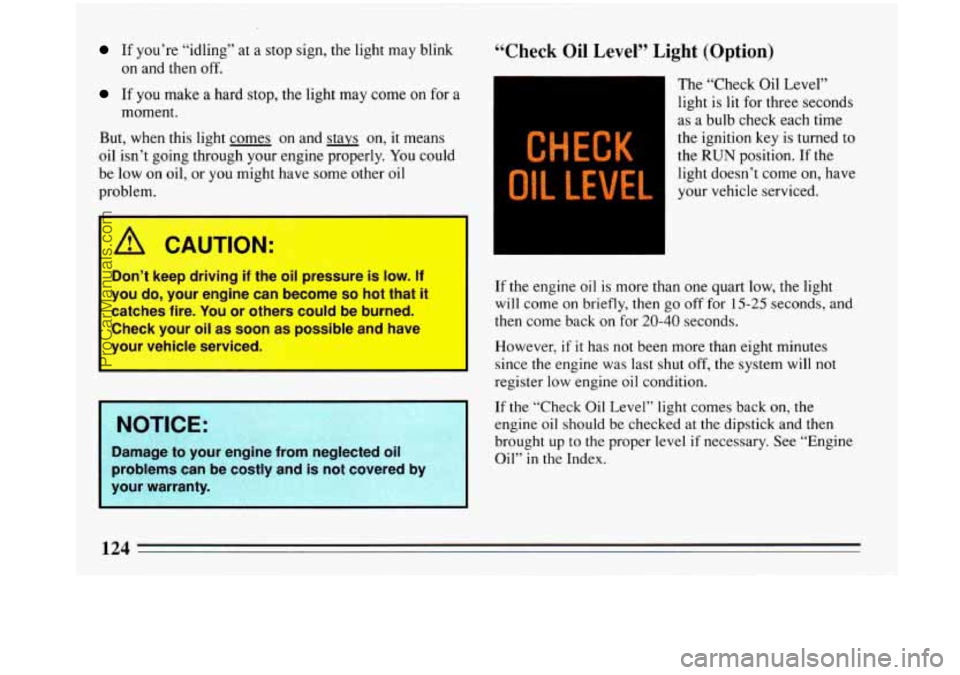
If you’re “idling” at a stop sign, the light may blink
on and then
off.
If you make a hard stop, the light may come on for a
moment.
But, when this light comes on and stays on, it means
oil isn’t going through your engine properly.
You could
be low on oil, or you might have some other oil
problem.
A CAUTION:
Don’t keep driving if the oil pressure is low. If
you
do, your engine can become so hot that it
catches fire. You or others could be burned.
Check your oil as soon as possible and have
your vehicle serviced.
NOTICE:
Damage to your engine from neglected oil
problems can be costly and is not covered by
your warranty.
“Check Oil Level’’ Light (Option)
CHECK
OIL LEVEL
The “Check Oil Level”
light is lit for three seconds
as a bulb check each time
the ignition key is turned
to
the RUN position. If the
light doesn’t come on, have
your vehicle serviced.
If the engine oil is more than one quart low, the light
will come on briefly, then go off for 15-25 seconds, and
then come back
on for 20-40 seconds.
However,
if it has not been more than eight minutes
since the engine was last shut
off, the system will not
register low engine oil condition.
If the “Check Oil Level” light comes back on, the
engine
oil should be checked at the dipstick and then
brought up to the proper level if necessary. See “Engine
Oil” in the Index.
ProCarManuals.com
Page 192 of 340
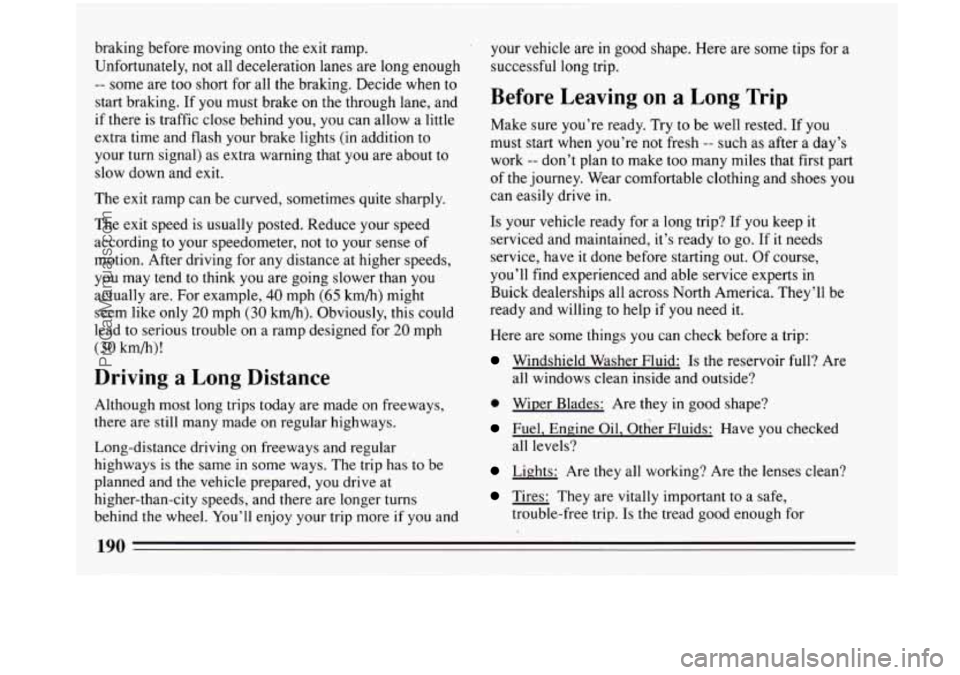
braking before moving onto the exit ramp.
Unfortunately, not all deceleration
lanes are long enough
-- some are too short for all the braking. Decide when to
start braking. If you must brake on the through lane, and
if there is traffic close behind
you, you can allow a little
extra time and flash your brake lights (in addition to
your turn signal) as extra warning that you are about to
slow down and exit.
The exit ramp can be curved, sometimes quite sharply.
The exit speed is usually posted. Reduce your speed
according to your speedometer, not to your sense of
motion. After driving for any distance at higher speeds,
you may tend
to think you are going slower than you
actually are. For example,
40 mph (65 km/h) might
seem like only
20 mph (30 km/h). Obviously, this could
lead to serious trouble on a ramp designed for
20 mph
(30 km/h)!
Driving a Long Distance
Although most long trips today are made on freeways,
there are still many made on regular highways.
Long-distance driving on freeways and regular
highways
is the same in some ways. The trip has to be
planned and
the vehicle prepared, you drive at
higher-than-city speeds, and there are longer turns
behind the wheel. You’ll enjoy your trip more
if you and your vehicle
are in good shape. Here are some tips for a
successful long trip.
Before Leaving on a Long Trip
Make sure you’re ready. Try to be well rested. If you
must start when you’re not fresh -- such as after a day’s
work
-- don’t plan to make too many miles that first part
of the journey. Wear comfortable clothing and shoes you
can easily drive
in.
Is your vehicle ready for a long trip? If you keep it
serviced and maintained, it’s ready to go. If it needs
service, have it done before starting out. Of course,
you’ll find experienced and able service experts in
Buick dealerships all across North America. They’ll be
ready and willing to help if
you need it.
Here are some things you can check before a trip:
Windshield Washer Fluid: Is the reservoir full? Are
all windows clean inside and outside?
0 Wiper Blades: Are they in good shape?
Fuel, Engine Oil, Other Fluids: Have you checked
Lights: Are they all working? Are the lenses clean?
Tires: They are vitally important to a safe,
all levels?
trouble-free trip. Is
the tread good enough
for
ProCarManuals.com
Page 225 of 340
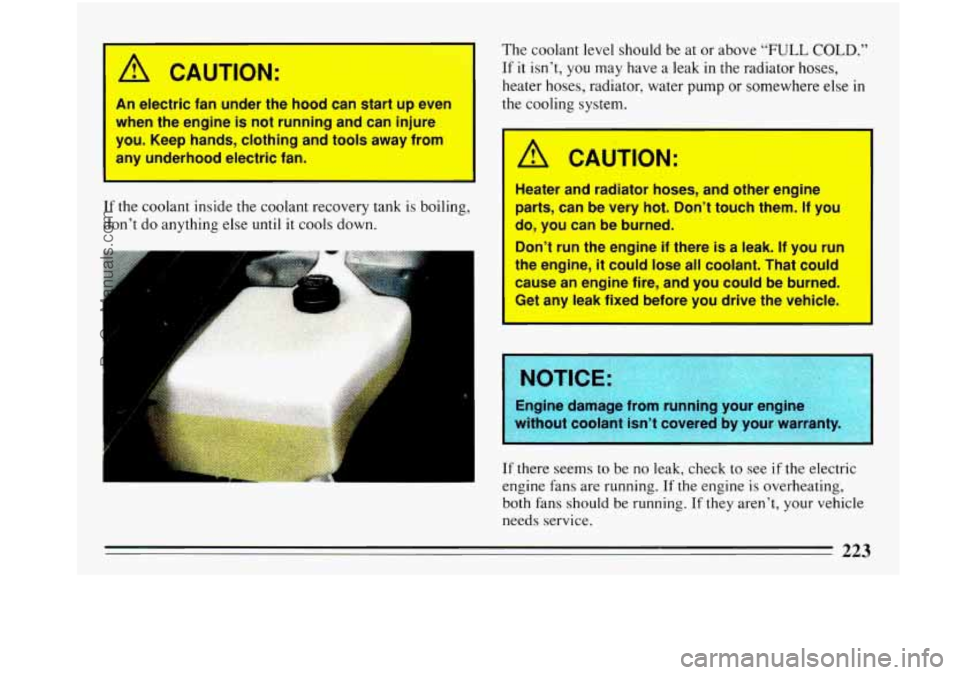
I A CAUTION:
An electric fan under the hood can start up even
when the engine
is not running and can injure
you. Keep hands, clothing and tools away from
any underhood electric fan.
If the coolant inside the coolant recovery tank is boiling,
don’t do anything else until it cools down.
. .” P
The coolant level should be at or above “FULL COLD.”
If it isn’t, you may have a leak in the radiator hoses,
heater hoses, radiator, water pump
or somewhere else in
the cooling system.
I I
A CAUTION:
Heater and radiator hoses, and other engine
parts, can be very hot. Don’t touch them.
If you
do, you can be burned.
Don’t run the engine
if there is a leak. If you run
the engine, it could lose all coolant. That could
cause an engine fire, and you could be burned.
Get any leak fixed before you drive the vehicle.
I
Engine damage? Il’onl I mning bUrlr engine
without coolant isn’t covered by your warrbllr
If there seems to be no leak, check to see if the electric
engine fans are running. If the engine
is overheating,
both fans should be running. If they aren’t, your vehicle
needs service.
223
ProCarManuals.com
Page 243 of 340
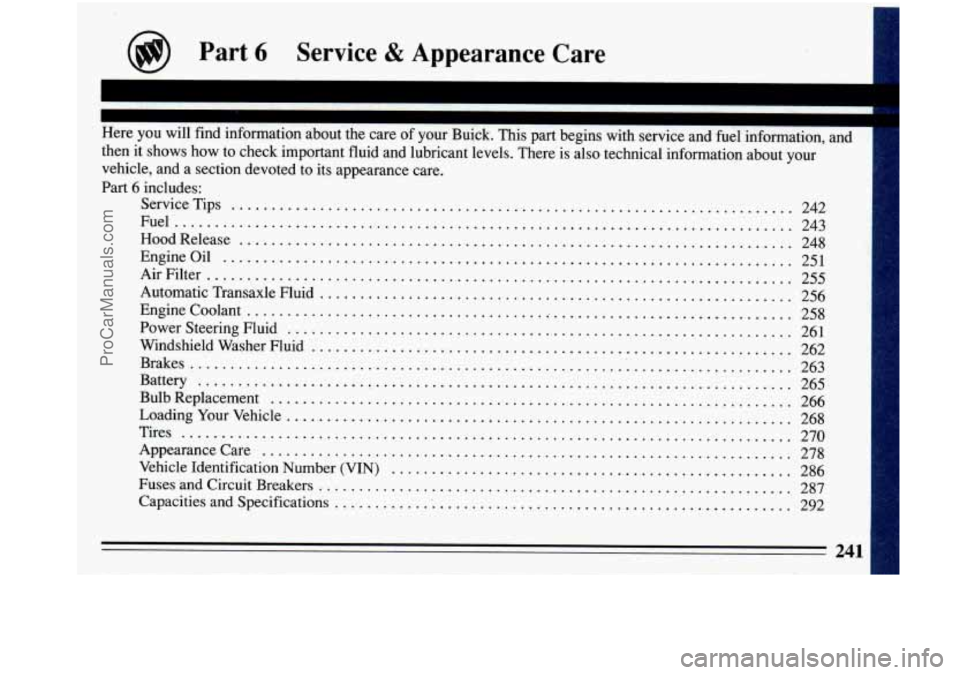
I
I
Here you will find information about the care of your Buick . This part begins with service and fuel information. and
then it shows how to check important fluid and lubricant levels
. There is also technical information about your
vehicle. and a section devoted to its appearance care
.
Part 6 includes:
ServiceTips
......................................................................
Engineoil ....................................................................... \
242
Fuel
........................................................................\
..... 243
Hood Release 248
251
AirFilter
........................................................................\
. 255
Automatic Transaxle Fluid
...........................................................
Enginecoolant .................................................................... 258
PowerSteeringFluid
............................................................... 261
Windshield Washer Fluid
............................................................ 262
Brakes
........................................................................\
... 263
Battery
........................................................................\
... 265
266
268
270
278
Vehicle Identification Number (VIN)
.................................................. 286
Fuses .and Circuit Breakers
........................................................... 287
Capacities and Specifications
.......................................................... 292
.....................................................................
256
BulbReplacement
.................................................................
LoadingYourVehicle ...............................................................
Tires ........................................................................\
....
Appearancecare ..................................................................
241
ProCarManuals.com
Page 247 of 340
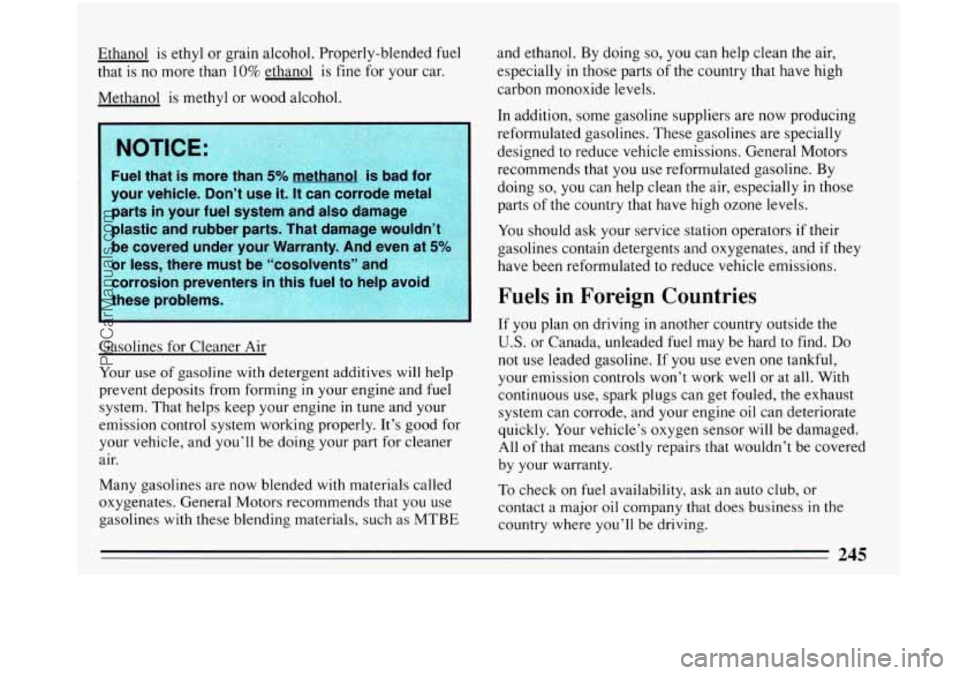
Ethanol is ethyl or grain alcohol. Properly-blended fuel
that is no more than
10% ethanol is fine for your car.
Methanol is methyl or wood alcohol.
Fuel that is more than 5% methanol is bad for
your vehicle. Don’t use it.
It can corrode metal
parts in your fuel system and also damage
plastic and rubber parts. That damage wouldn’t be covered under your Warranty. And even at
5%
or less, there must be “cosolvents” and
corrosion preventers in this fuel to help avoid
Gasolines for Cleaner Air
Your use
of gasoline with detergent additives will help
prevent deposits from forming
in your engine and fuel
system. That helps keep your engine in tune and your
emission control system working properly. It’s good for
your vehicle, and you’ll be doing your part for cleaner
air.
Many gasolines are now blended with materials called
oxygenates. General Motors recommends that you use
gasolines with these blending materials, such as MTBE and ethanol.
By doing
so, you can help clean the air,
especially
in those parts of the country that have high
carbon monoxide levels.
In addition, some gasoline suppliers are now producing
reformulated gasolines. These gasolines are specially
designed to reduce vehicle emissions. General Motors
recommends that you use reformulated gasoline. By
doing
so, you can help clean the air, especially in those
parts of the country that have high ozone levels.
You should ask your service station operators if their
gasolines contain detergents and oxygenates, and if they
have been reformulated to reduce vehicle emissions.
Fuels in
Foreign Countries
If you plan on driving in another country outside the
U.S. or Canada, unleaded fuel may be hard to find. Do
not use leaded gasoline. If you use even one tankful,
your emission controls won’t work well or at all. With
continuous use, spark plugs can get fouled,
the exhaust
system can corrode, and your engine oil can deteriorate
quickly. Your vehicle’s oxygen sensor will be damaged.
All
of that means costly repairs that wouldn’t be covered
by your warranty.
To check on fuel availability, ask an auto club, or
contact a major oil company that does business
in the
country where you’ll be driving.
245
ProCarManuals.com
Page 253 of 340
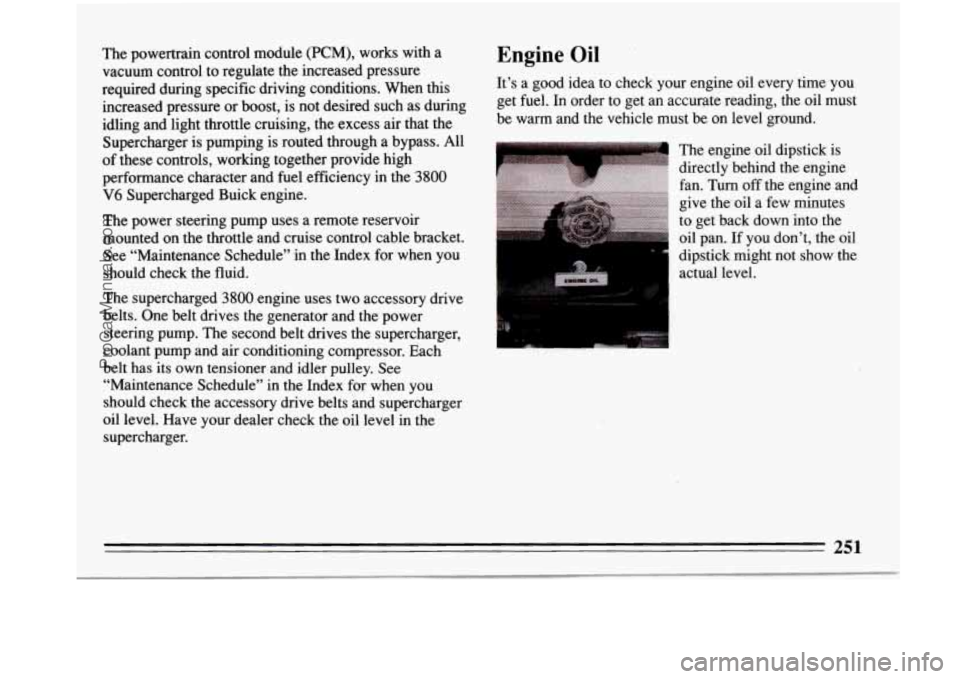
The powertrain control module (PCM), works with a
vacuum control to regulate the increased pressure
required during specific driving conditions. When this
increased pressure or boost, is not desired such as during
idling and light throttle cruising, the excess air that the
Supercharger is pumping is routed through a bypass. All
of these controls, working together provide high
performance character and fuel efficiency in the
3800
V6 Supercharged Buick engine.
The power steering pump uses a remote reservoir
mounted on the throttle and cruise control cable bracket.
See “Maintenance Schedule’’ in the Index for when you
should check the fluid.
The supercharged
3800 engine uses two accessory drive
belts. One belt drives the generator and the power
steering pump. The second belt drives the supercharger,
coolant pump and air conditioning compressor. Each
belt has
its own tensioner and idler pulley. See
“Maintenance Schedule’’ in the Index for when you
should check the accessory drive belts and supercharger
oil level. Have your dealer check the oil level in the
supercharger.
Engine Oil
It’s a good idea to check your engine oil every time you
get fuel. In order to get an accurate reading, the oil must
be warm and the vehicle must be on level ground.
The engine oil dipstick is
directly behind the engine
fan. Turn
off the engine and
give the oil a few minutes
to get back down into the
oil pan. If you don’t, the oil
dipstick might not &ow the
actual level.
ProCarManuals.com
Page 254 of 340
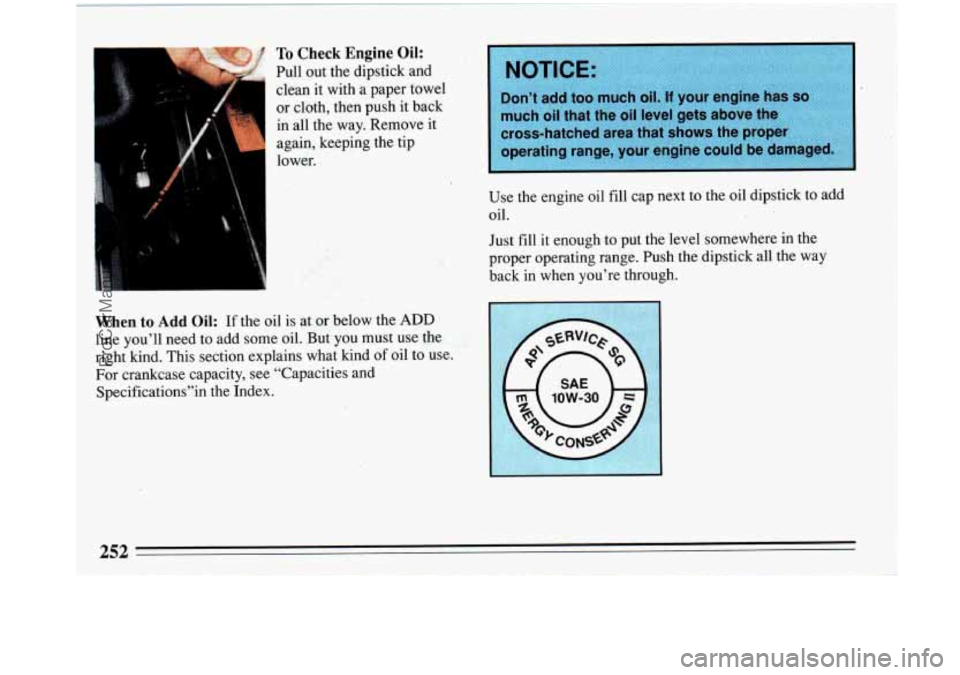
To Check Engine Oil:
Pull out the dipstick and
clean it with a paper towel
or cloth, then push it back
in all the way. Remove it
again, keeping the tip
lower.
I
i
When to Add Oil: If the oil is at or below the ADD
line you’ll need to add some oil. But you must use the
right kind. This section explains what kind of oil to use.
For crankcase capacity, see “Capacities and
Specifications”in the Index.
I NOTICE:
Don’t add too much oil. If your engine has so
much oil that the oil level gets above the
cross-hatched area that shows the proper operating range, your engine could be damaged,
Use the engine oil fill cap next to the oil dipstick to add
oil.
Just
fill it enough,to put the level somewhere in the
proper operating range. Push the-dipstick all the way
back in when you’re through.
252
ProCarManuals.com
Page 255 of 340
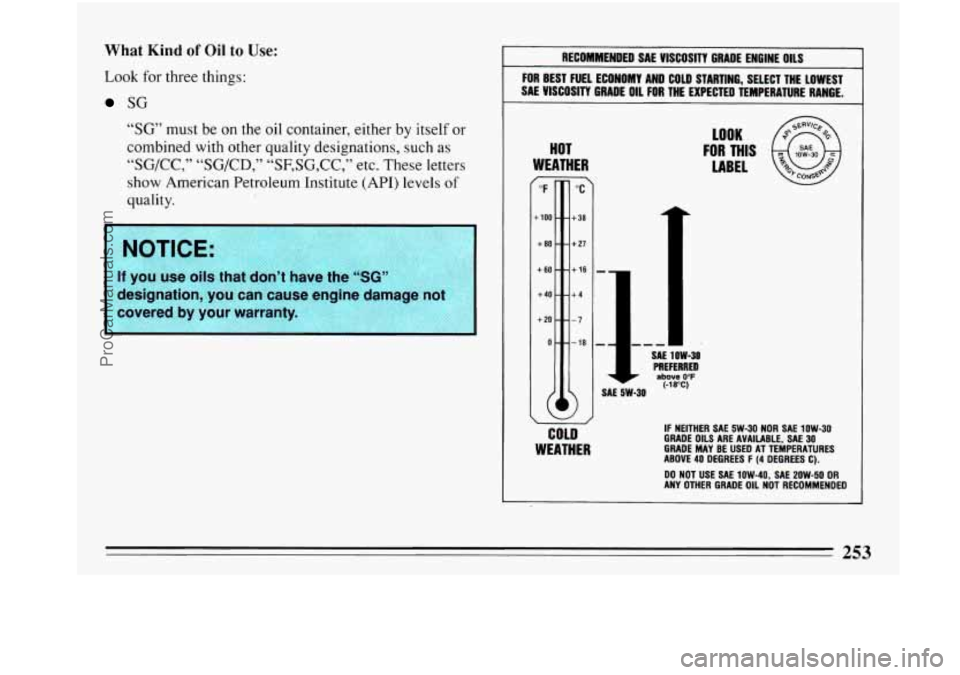
What Kind of Oil to Use:
Look for three things:
SG
“SG” must be on the oil container, either by itself or
combined with other quality designations, such as
“SG/CC,” “SG/CD,” “SF,SG,CC,” etc. These letters
show American Petroleum Institute (API) levels of
quality.
If you use oils that don’t have the “SG”
designation,
you can cause engine damage not I
covered by your warranty.
I
RECOMMENDED SAE VISCOSITY GRADE ENGINE OILS
FOR BEST FUEL ECONOMY AND COLD STARTING, SELECT THE LOWEST
SAE VISCOSITY GRADE
OIL FOR THE EXPECTED TEMPERATURE RANGE.
HOT
WEATHER
-
-
SAE 5W-30
LOOK
FOR THIS
LABEL
SAE 1OW-30
PREFERRED
above 0°F (-18%)
COLD
WEATHER
IF NEITHER SAE 5W-30 NOR SAE 1OW-30
GRADE OILS ARE AVAILABLE, SAE 30
GRADE MAY BE USED AT TEMPERATURES
ABOVE 40 DEGREES
F (4 DEGREES C).
ANY OTHER GRADE OIL NOT RECOMMENDED
DO
NOT USE SAE 1OW-40, SAE 2OW-50
OR
ProCarManuals.com
Page 258 of 340
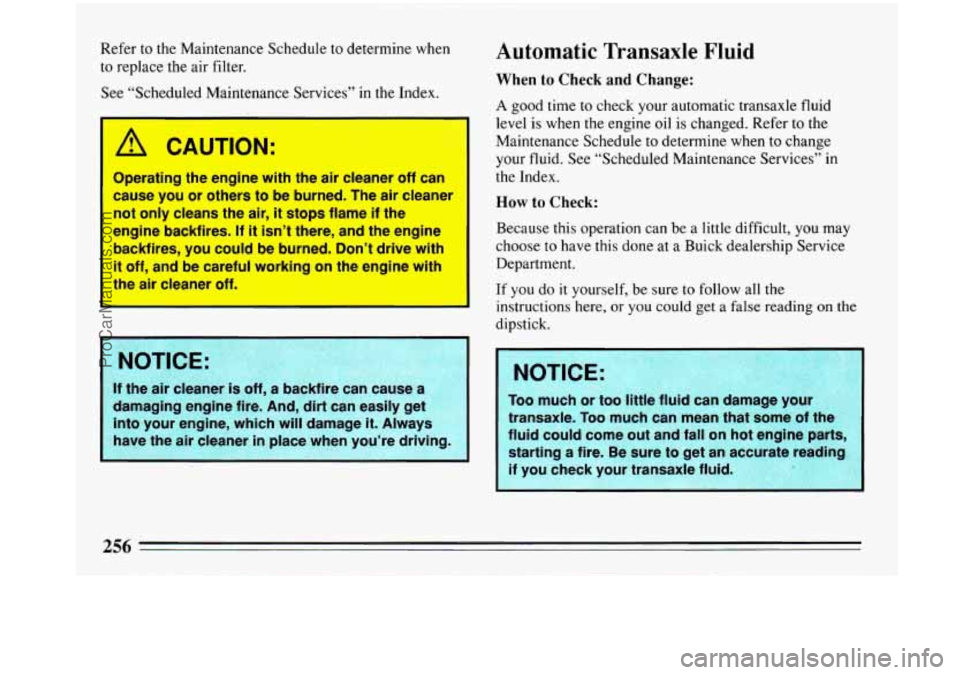
Refer to the Maintenance Schedule to determine when
to replace the air filter.
See “Scheduled Maintenance Services’’ in the Index.
A CAUTION:
Operating the engine with the air cleaner off can
cause you or others to be burned. The air cleaner
not only cleans the air, it stops flame
if the
engine backfires.
If it isn’t there, and the engine
backfires, you could be burned. Don’t drive with
it off, and be careful working on the engine with
the air cleaner off.
: NOTICE:
I If the air clean
i damaging engine fire. And, dirt can easily get
into your engine, which will damage
it. Always
’ have the air cleaner in place when you’re driving.
Automatic Transaxle Fluid
When to Check and Change:
A good time to check your automatic transaxle fluid
level is when the engine oil is changed. Refer to the
Maintenance Schedule to determine when to change
your fluid. See “Scheduled Maintenance Services” in
the Index.
How to Check:
Because this operation can be a little difficult, you may
choose to have this done at a Buick dealership Service Department.
If
you do it yourself, be sure to follow all the
instructions here, or
you could get a false reading on the
dipstick.
transaxle. Too much can mean that some of the
fluid could come out and fall on hot engine parts,
starting a fire. Be sure to get an
a
if you check your transaxle fluid.
ProCarManuals.com
Page 260 of 340
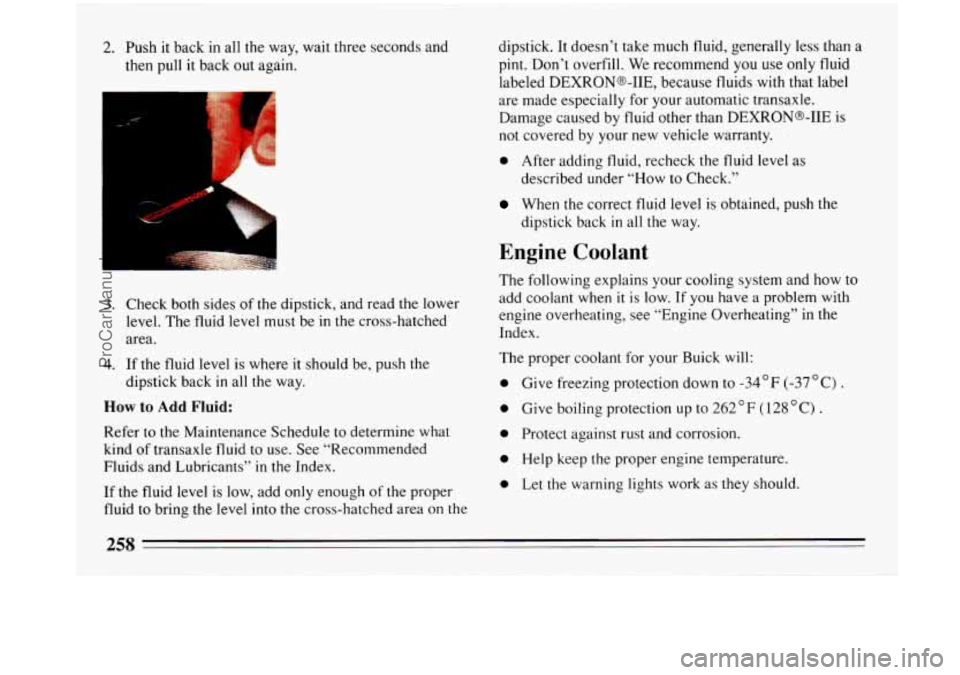
2. Push it back in all the way, wait three seconds and
then pull it back out again.
3. Check both sides of the dipstick, and read the lower
level. The fluid level must be in the cross-hatched
area.
4. If the fluid level is where it should be, push the
dipstick back
in all the way.
How to Add Fluid:
Refer to the Maintenance Schedule to determine what
kind of transaxle fluid to use. See “Recommended
Fluids and Lubricants” in the Index.
If the fluid level is low, add only enough of the proper
fluid to bring the level
into the cross-hatched area on the dipstick, It
doesn’t take much fluid, generally less than a
pint. Don’t overfill. We recommend
you use only fluid
labeled DEXRONWIE, because
fluids with that label
are made especially for your automatic transaxle.
Damage caused by fluid other than DEXRONB-IIE is
not covered by your new vehicle warranty.
0 After adding fluid, recheck the fluid level as
described under “How to Check.”
When the correct fluid level is obtained, push the
dipstick back
in all the way.
Engine Coolant
The following explains your cooling system and how to
add coolant when
it is low. If you have a problem with
engine overheating, see “Engine Overheating” in the
Index.
The proper coolant for your Buick will:
0 Give freezing protection down to -34°F (-37 “C) .
0 Give boiling protection up to 262 F ( 128 ” C) .
0 Protect against rust and corrosion.
0 Help keep the proper engine temperature.
0 Let the warning lights work as they should.
ProCarManuals.com